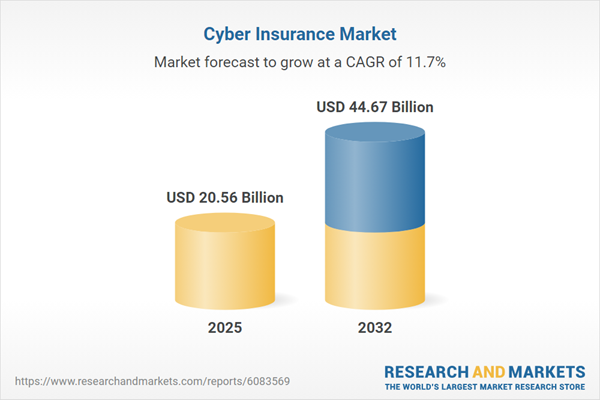Speak directly to the analyst to clarify any post sales queries you may have.
The cyber insurance market is undergoing pivotal changes as digital threats multiply and regulatory expectations evolve. As organizations integrate advanced technologies and optimize risk strategies, the demand for adaptive, robust insurance solutions is redefining industry benchmarks.
Market Snapshot: Cyber Insurance Market Growth and Opportunity
The cyber insurance market grew from USD 18.49 billion in 2024 to USD 20.56 billion in 2025, and is projected to maintain strong momentum with a CAGR of 11.65%, reaching USD 44.67 billion by 2032. This extends the relevance of cyber insurance for decision-makers seeking resilient risk-transfer strategies in a rapidly changing digital risk environment. Growth is driven by cloud adoption, remote work trends, and regulatory challenges, powering a robust marketplace braced for ongoing innovation.
Scope & Segmentation of the Cyber Insurance Market
This research delivers comprehensive insight into cyber insurance market dimensions, with broad coverage across components, coverage types, models, industry verticals, organization size, and geography. Explore the following critical segmentation areas:
- Component: Services including consulting, advisory, and security awareness training; Solutions such as cybersecurity insurance analytics platforms and disaster recovery & business continuity.
- Coverage Type: Business interruption, data breach, network security.
- Insurance Type: Packaged policies, stand-alone cyber insurance.
- End User Industry: Banking, financial services, insurance, consumer goods and retail, energy and utilities, government and public sector, healthcare, IT and telecom, manufacturing and industrial.
- Organization Size: Large enterprises, small and medium enterprises.
- Region: Americas (including North America: United States, Canada, Mexico; Latin America: Brazil, Argentina, Chile, Colombia, Peru), Europe, Middle East & Africa (United Kingdom, Germany, France, Russia, Italy, Spain, Netherlands, Sweden, Poland, Switzerland, United Arab Emirates, Saudi Arabia, Qatar, Turkey, Israel, South Africa, Nigeria, Egypt, Kenya), Asia-Pacific (China, India, Japan, Australia, South Korea, Indonesia, Thailand, Malaysia, Singapore, Taiwan).
- Key Companies: Allianz SE, American International Group, Aon PLC, AXA SA, Beazley Plc, Berkshire Hathaway Specialty Insurance, BitSight Technologies, China Pacific Insurance, Chubb, Cyber Indemnity Solutions, CyberArk Software, HDI Global SE, Hiscox, Kovrr, Liberty Mutual, Lloyd’s of London, Markel Group, Munich Re, Progressive Corporation, Royal & Sun Alliance, Sompo International, Starr International, Swiss Re, The Allstate Corporation, The Baldwin Insurance Group, The Travelers Companies, Tokio Marine HCC, Zurich Insurance Company.
Key Takeaways for Senior Decision-Makers
- The escalating complexity of digital threats requires cyber insurance solutions that extend beyond traditional indemnity, including risk advisory and incident response capabilities.
- Technological advances such as AI-driven analytics and automated threat detection are enhancing underwriter precision, and fostering adaptive policy models.
- Strong partnerships between insurers, cybersecurity providers, and legal experts are reshaping value chains, resulting in end-to-end risk management offerings for clients.
- Sector-specific demands drive tailored policy frameworks, as industries like BFSI, healthcare, and manufacturing require differentiated protections aligned with their operational risks.
- Market maturity varies by region, underlining the strategic value of adapting product offerings to local regulatory conditions and digital readiness levels.
Tariff Impact on Cyber Insurance Value Chain
Recent US tariff measures have affected the cyber insurance sector by increasing costs for technology imports critical to security infrastructure. Higher procurement expenses filter through to insurers, influencing premium structures and underwriting criteria. Supply chain adaptations, including localization and alternative sourcing, introduce new underwriting considerations, such as vendor stability and operational resilience. As a result, policy terms and risk models are being redefined to maintain alignment with an evolving cost landscape.
Methodology & Data Sources
This report integrates primary interviews with sector executives and multi-industry end users, together with secondary research from industry whitepapers, regulatory filings, and market disclosures. Quality assurance measures include data triangulation, peer review, and market segmentation validation to ensure accuracy and actionable insights.
Why This Report Matters for Cyber Insurance Leaders
- Enables strategic decisions by detailing emerging risks, sector-specific trends, and regulatory changes impacting cyber insurance.
- Delivers actionable intelligence for optimizing product strategies, partnership models, and compliance frameworks.
- Equips leaders with knowledge to benchmark offerings and identify growth markets or M&A opportunities within dynamic regions.
Conclusion
The cyber insurance market is evolving swiftly, shaped by technological advancement, regulatory shifts, and sector-driven needs. With clear market intelligence, leaders can enhance resilience, refine coverage strategies, and approach future challenges with confidence.
Table of Contents
3. Executive Summary
4. Market Overview
7. Cumulative Impact of Artificial Intelligence 2025
Companies Mentioned
The companies profiled in this Cyber Insurance market report include:- Allianz SE
- American International Group
- Aon PLC
- AXA SA
- Beazley Plc
- Berkshire Hathaway Specialty Insurance
- BitSight Technologies, Inc.
- China Pacific Insurance (Group) Co., Ltd.
- Chubb Group of Insurance Companies
- Cyber Indemnity Solutions Ltd
- CyberArk Software Ltd.
- HDI Global SE by Talanx Group
- Hiscox Inc.
- Kovrr Inc
- Liberty Mutual Insurance Company
- Lloyd's of London Ltd.
- Markel Group Inc.
- Munich Re Group
- Progressive Corporation
- Royal & Sun Alliance Insurance Limited
- Sompo International
- Starr International Company, Inc.
- Swiss Re Ltd
- The Allstate Corporation
- The Baldwin Insurance Group Holdings, LLC
- The Travelers Companies, Inc.,
- Tokio Marine HCC
- Zurich Insurance Company Ltd
Table Information
| Report Attribute | Details |
|---|---|
| No. of Pages | 194 |
| Published | November 2025 |
| Forecast Period | 2025 - 2032 |
| Estimated Market Value ( USD | $ 20.56 Billion |
| Forecasted Market Value ( USD | $ 44.67 Billion |
| Compound Annual Growth Rate | 11.6% |
| Regions Covered | Global |
| No. of Companies Mentioned | 29 |









